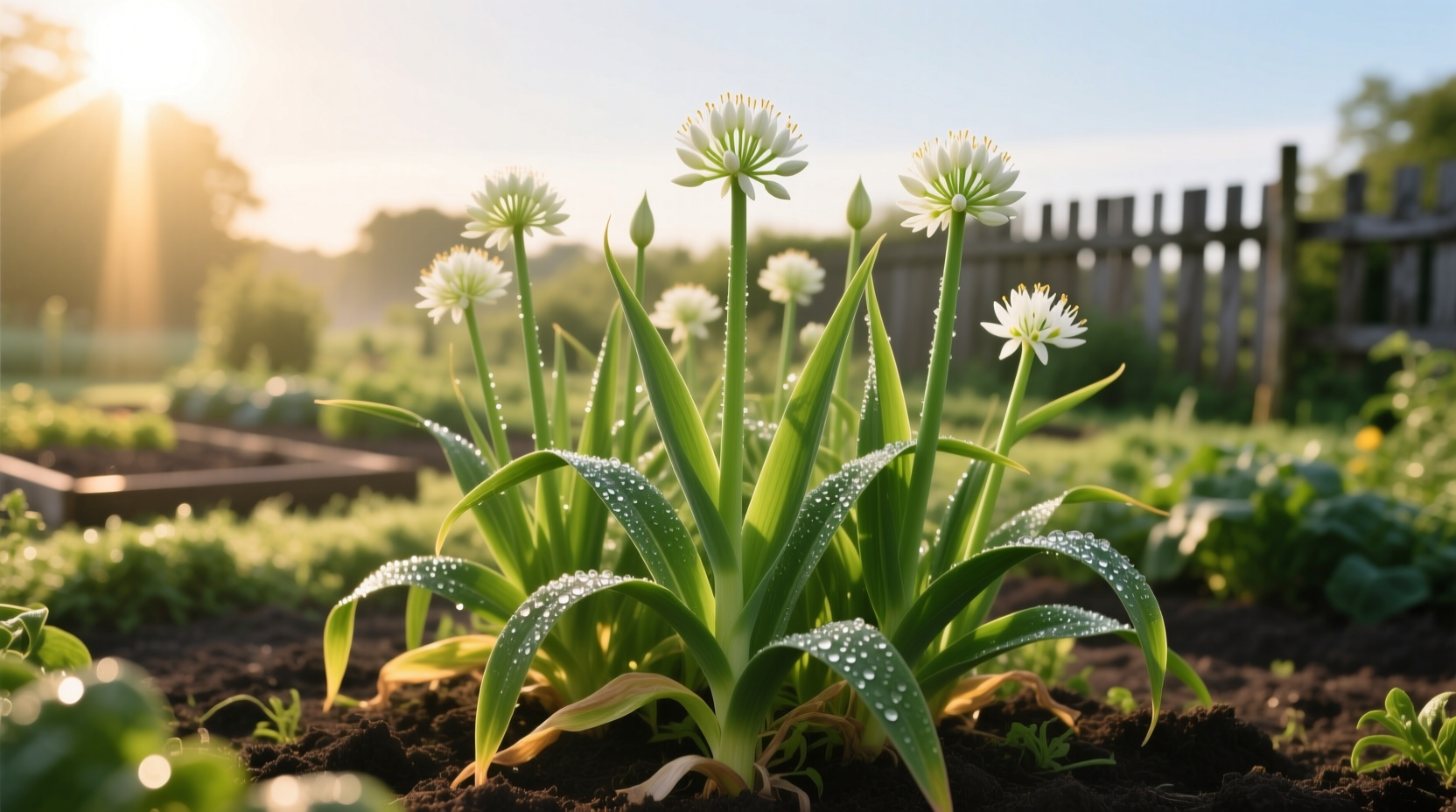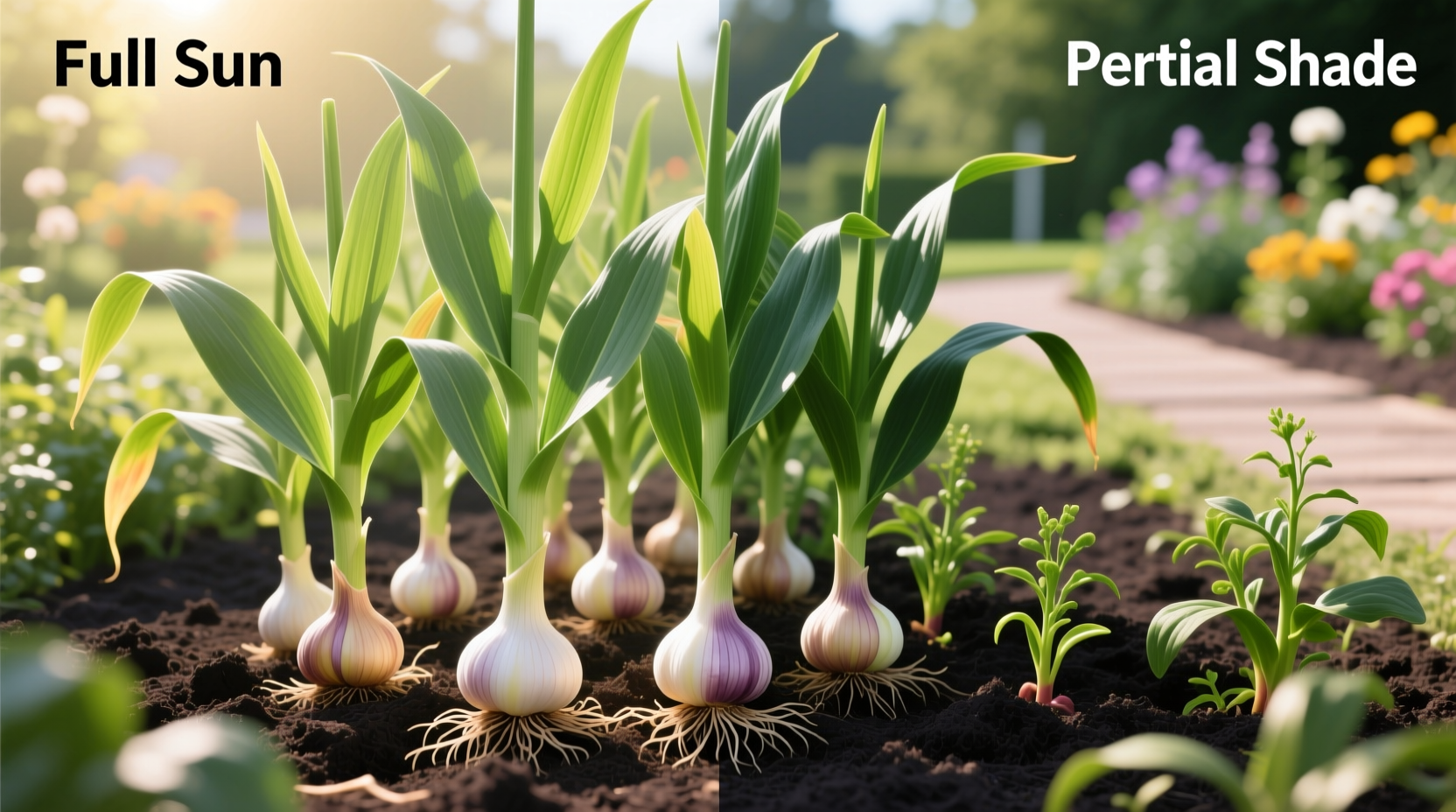Yes, garlic generally requires full sun (6-8 hours of direct sunlight daily) for optimal bulb development, though it can tolerate partial shade in hotter climates. Proper sunlight exposure directly impacts bulb size, flavor intensity, and disease resistance in your garlic crop.
Understanding exactly how much sun garlic needs can make the difference between a bountiful harvest and disappointing results. As a gardener, you've probably heard conflicting advice about garlic's sunlight requirements. Let's clarify exactly what your garlic needs to thrive based on scientific research and practical growing experience.
Garlic's Sunlight Requirements Explained
Garlic (Allium sativum) is a sun-loving plant that performs best with consistent, direct sunlight. While "full sun" is the standard recommendation, the reality is more nuanced depending on your specific growing conditions.
Research from agricultural extension programs consistently shows that garlic needs a minimum of 6 hours of direct sunlight daily for acceptable growth, with 8 hours being ideal for maximum bulb development. The University of California Cooperative Extension confirms that "garlic requires full sun for best bulb development, with at least six hours of direct sun daily."
| Climate Zone | Recommended Sunlight | Special Considerations |
|---|---|---|
| Zones 3-7 (Cooler climates) | Full sun (8+ hours) | Maximize sunlight exposure for larger bulbs |
| Zones 8-10 (Warmer climates) | 6-8 hours with afternoon shade | Protect from intense afternoon sun to prevent scorching |
| All zones (Spring growth phase) | Maximum available sunlight | Critical period for bulb formation requires abundant light |
Why Sunlight Matters for Garlic Growth
Sunlight directly affects three critical aspects of garlic development:
- Bulb size - Photosynthesis drives energy production that gets stored in the bulb
- Flavor intensity - Sun exposure influences the development of sulfur compounds responsible for garlic's characteristic taste
- Disease resistance - Proper sun exposure helps keep foliage dry, reducing fungal disease risks
A study published in the HortScience Journal demonstrated that garlic grown with less than 6 hours of daily sunlight produced bulbs 30-40% smaller than those grown in full sun conditions. The research also noted reduced allicin content (the compound responsible for many of garlic's health benefits) in plants receiving insufficient light.

Adapting Sunlight Requirements to Your Climate
The "full sun" recommendation needs adjustment based on your specific climate conditions:
Cooler Climate Growing (Zones 3-7)
In northern regions with cooler summers, garlic benefits from maximum possible sunlight. These areas rarely experience temperatures that would stress garlic plants from too much sun. In fact, the Old Farmer's Almanac recommends "planting in the sunniest spot available" for northern gardeners.
Warmer Climate Growing (Zones 8-10)
Gardeners in southern regions need to modify the full sun approach. The USDA Agricultural Research Service notes that in hotter climates, "afternoon shade can prevent leaf scorch and reduce water stress" for garlic plants. Consider positioning your garlic beds to receive morning sun but some protection from the intense afternoon rays.
Practical Sunlight Assessment for Your Garden
Before planting, evaluate your garden's light patterns:
- Track sunlight patterns - Observe your garden throughout the day during the growing season
- Use a sunlight calculator app - Many free smartphone apps can measure daily sunlight exposure
- Consider seasonal changes - Remember that sun angles change throughout the growing season
- Watch for shifting shadows - Trees and structures may cast different shadows as the season progresses
The Royal Horticultural Society recommends that gardeners "map sunlight patterns over several days to understand the true light conditions in potential garlic planting areas." This is particularly important if you're considering spots that might receive morning sun but afternoon shade.
Troubleshooting Sunlight-Related Issues
Recognizing problems related to improper sunlight exposure can help you adjust for future plantings:
Signs of Insufficient Sunlight
- Thin, weak stalks that fall over easily
- Smaller than expected bulb size
- Increased susceptibility to fungal diseases
- Pale green rather than vibrant green foliage
Solutions for Low Light Conditions
- Trim surrounding vegetation that casts shade
- Consider reflective mulches to increase light exposure
- Choose planting locations carefully for next season
- Opt for softneck varieties which may be slightly more shade-tolerant
Complementary Factors for Successful Garlic Growing
Sunlight works in conjunction with other growing conditions:
- Soil preparation - Well-draining soil with plenty of organic matter supports healthy growth regardless of sunlight conditions
- Watering schedule - Consistent moisture is especially important when plants receive maximum sun exposure
- Planting timing - Fall planting (in most climates) allows garlic to establish roots before winter and take full advantage of spring sunlight
- Companion planting - Avoid planting near tall plants that will shade your garlic as they grow
Remember that while sunlight is crucial, it's just one component of successful garlic cultivation. The Cornell University Gardeners' Resource emphasizes that "optimal garlic production requires attention to multiple factors working together - sunlight, soil conditions, proper planting depth, and appropriate watering."
FAQ: Common Garlic Sunlight Questions
Can garlic grow in partial shade?
Yes, garlic can grow in partial shade (4-6 hours of direct sun), but with reduced yields. In cooler climates, expect smaller bulbs with less intense flavor. In warmer zones (8+), partial shade can actually benefit garlic by protecting it from intense afternoon sun that might cause leaf scorch.
How does sunlight affect garlic flavor?
Sunlight directly impacts garlic's flavor compounds. Research from the Journal of Agricultural and Food Chemistry shows that adequate sun exposure increases allicin production, resulting in more intense, complex flavors. Garlic grown with insufficient light often produces milder, less complex flavors and smaller bulbs with fewer cloves.
What happens if garlic gets too much sun?
In extremely hot climates (zones 9-10), too much direct sun, particularly intense afternoon sun, can cause leaf scorch, increased water stress, and reduced bulb development. The USDA notes that in these regions, providing some afternoon shade can actually improve yields by preventing heat stress while still providing sufficient morning sunlight.
Does garlic need different sunlight in different growth stages?
Yes, garlic has varying sunlight needs throughout its growth cycle. During the initial root development phase (fall planting in most climates), moderate sun is sufficient. The critical bulb formation period (spring) requires maximum sunlight exposure. As harvest approaches (late spring/early summer), slightly reduced sun can help with proper curing. The University of Vermont Extension recommends maximizing sun exposure during the 4-6 week period when bulb formation occurs.











 浙公网安备
33010002000092号
浙公网安备
33010002000092号 浙B2-20120091-4
浙B2-20120091-4